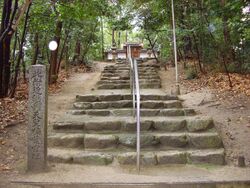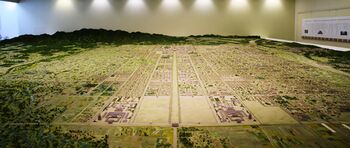Place:Capital of Japan
The capital of Japan is Tokyo.[1][2][3] Throughout history, the national capital has been in locations other than Tokyo.
History
Traditionally, the home of the Emperor is considered the capital. From 794 through 1868, the Emperor lived in Heian-kyō, modern-day Kyoto.[4][5] After 1868, the seat of the Government of Japan and the location of the Emperor's home was moved to Edo, which it renamed Tokyo.[6]
In 1941, the Ministry of Education published the "designation of Tokyo as capital" (東京奠都 Tōkyō-tento).[7]
Modern law
While no laws have designated Tokyo as the Japanese capital, many laws have defined a "capital area" (首都圏 shuto-ken) that incorporates Tokyo. Article 2 of the Capital Area Consolidation Law (首都圏整備法) of 1956 states: "In this Act, the term 'capital area' shall denote a broad region comprising both the territory of the Tokyo Metropolis as well as outlying regions designated by cabinet order." This implies that the government has designated Tokyo as the capital of Japan, although (again) it is not explicitly stated, and the definition of the "capital area" is purposely restricted to the terms of that specific law.[8]
Other laws referring to this "capital area" include the Capital Expressway Public Corporation Law (首都高速道路公団法) and the Capital Area Greenbelt Preservation Law (首都圏近郊緑地保全法).[9]
This term for capital was never used to refer to Kyoto. Indeed, shuto came into use during the 1860s as a gloss of the English term "capital".
The Ministry of Education published a book called "History of the Restoration" in 1941. This book referred to "designating Tokyo as capital" (東京奠都 Tōkyō-tento) without talking about "relocating the capital to Tokyo" (東京遷都 Tōkyō-sento). A contemporary history textbook states that the Meiji government "moved the capital (shuto) from Kyoto to Tokyo" without using the sento term.[7]
As of 2007, there is a movement to transfer the government functions of the capital from Tokyo while retaining Tokyo as the de facto capital, with the Gifu-Aichi region, the Mie-Kio region and other regions submitting bids for a de jure capital. Officially, the relocation is referred to as "capital functions relocation" instead of "capital relocation", or as "relocation of the Diet and other organizations".[10][11]
In 2023, the Government of Japan moved the Agency for Cultural Affairs to Kyoto. This was the first time that a central government office has been relocated outside Tokyo since Tokyo was designated as the capital.[12][13]
List of capitals
Legendary
This list of legendary capitals of Japan begins with the reign of Emperor Jimmu. The names of the Imperial palaces are in parentheses:
- Kashihara, Yamato at the foot of Mount Unebi during reign of Emperor Jimmu[14]
- Kazuraki, Yamato during reign of Emperor Suizei[15]
- Katashiha, Kawachi during the reign of Emperor Annei[15]
- Karu, Yamato during reign of Emperor Itoku.[16]
- Waki-no-kami, Yamato during the reign of Emperor Kōshō[17]
- Muro, Yamato during reign of Emperor Kōan[17]
- Kuruda, Yamato during the reign of Emperor Kōrei[17]
- Karu, Yamato during reign of Emperor Kōgen[17]
- Izakaha, Yamato during reign of Emperor Kaika[17]
- Shika, Yamato (Palace of Mizugaki) during reign of Emperor Sujin[18]
- Shika, Yamato (Palace of Tamagaki) during reign of Emperor Suinin[19]
- Makimuko, Yamato (Palace of Hishiro) during reign of Emperor Keikō[20]
- Shiga, Ōmi (Palace of Takaanaho) during reign of Emperor Seimu[21]
- Ando, Nara (Palace of Toyoura) and Kashiki on the island of Kyushu during reign of Emperor Chūai[21]
Historical
This list of capitals includes the Imperial palaces names in parentheses.
Kofun period
- Karushima, Yamato (Palace of Akira), reign of Emperor Ōjin[22]
- Naniwa, Settsu (Palace of Takatsu), reign of Emperor Nintoku[23]
- Iware, Yamato (Palace of Wakasakura), reign of Emperor Richū[24]
- Tajihi, Kawachi (Palace of Shibakaki), reign of Emperor Hanzei[25]
- Asuka, Yamato (Palace of Tohotsu), reign of Emperor Ingyō[26]
- Isonokami, Yamato (Palace of Anaho), reign of Emperor Ankō[27]
- Sakurai, Nara (Hatsuse no Asakura Palace), 457–479[28] in reign of Emperor Yūryaku[29]
- Sakurai, Nara (Iware no Mikakuri Palace), 480–484[28] in reign of Emperor Seinei[30]
- Asuka, Yamato (Chikatsu-Asuka-Yatsuri Palace), 485–487[31] in reign of Emperor Kenzō[30]
- Tenri, Nara (Isonokami Hirotaka Palace), 488–498[28] in reign of Emperor Ninken[32]
- Sakurai, Nara (Nimiki Palace), 499–506 in reign of Emperor Buretsu[32]
- Hirakata, Osaka (Kusuba Palace), 507–511[citation needed][33]
- Kyōtanabe, Kyoto (Tsutsuki Palace), 511–518 in reign of Emperor Keitai[28][34]
- Nagaoka-kyō (Otokuni Palace), 518–526 in reign of Keitai[28][35]
- Sakurai, Nara (Iware no Tamaho Palace), 526–532[28] in reign of Keitai[36]
- Kashihara, Nara (Magari no Kanahashi Palace), 532–535[28] in reign of Emperor Ankan[37]
- Sakurai, Nara (Hinokuma no Iorino Palace), 535–539[28] in reign of Emperor Senka[37]
Asuka period
- Asuka, Yamato (Shikishima no Kanasashi Palace), 540–571[28] in reign of Emperor Kinmei[37]
- Kōryō, Nara (Kudara no Ohi Palace), 572–575 [citation needed]
- Sakurai, Nara (Osata no Sakitama Palace or Osada no Miya), 572–585[38] in reign of Emperor Bidatsu[39]
- Shiki District, Nara (Iwareikebe no Namitsuki Palace), 585–587[40] in the reign of Emperor Yōmei[41]
- Shiki District, Nara (Kurahashi no Shibagaki Palace), 587–592[28] in the reign of Emperor Sushun[41]
- Asuka, Yamato (Toyura Palace or Toyura-no-miya), 593–603[42] in the reign of Empress Suiko[43]
- Asuka, Yamato (Oharida Palace or Oharida-no-miya), 603–629[42] in the reign of Suiko[43]
- Asuka, Yamato (Okamoto Palace or Oakmoto-no-miya), 630–636[42] in the reign of Emperor Jomei[44]
- Kashihara, Nara (Tanaka Palace or Tanaka-no-miya), 636–639[42]
- Kōryō, Nara (Umayasaka Palace or Umayasaka-no-miya, 640[42]
- Kōryō, Nara (Kudara Palace or Kudara-no-miya), 640–642[42]
- Asuka, Yamato (Oharida Palace), 642–643
- Asuka, Yamato (Itabuki Palace or Itabuki no miya), 643–645[42] in the reign of Empress Kōgyoku[44]
- Osaka (Naniwa Nagara-Toyosaki Palace), 645–654[45] in the reign of Emperor Kōtoku[46]
- Asuka, Yamato (Itabuki Palace), 655–655[42] in the reign of Kōtoku[46]
- Asuka, Yamato (Kawahara Palace or Kawahara-no-miya), 655–655[42]
- Asuka, Yamato (Okamoto Palace or Nochi no Asuka-Okamoto-no-miya), 656–660[42] in the reign of Emperor Saimei[47]
- Asakura, Fukuoka (Asakura no Tachibana no Hironiwa Palace or Asakure no Tachibana no Hironiwa-no-miya), 660–661[42]
- Osaka , (Naniwa Nagara-Toyosaki Palace), 661–667[45]
- Ōtsu, Shiga (Ōmi Ōtsu Palace or Ōmi Ōtsu-no-miya), 667–672[48] in reign of Emperor Tenji[47] and the reign of Emperor Kōbun[49]
- Asuka, Yamato (Kiyomihara Palace or Kiomihara-no-miya), 672–694[42] in the reign of Emperor Tenmu[50] and in the reign of Empress Jitō[51]
- Fujiwara-kyō (Fujiwara Palace), 694–710[52] in the reign of Emperor Monmu[51]
Nara period
- Heijō-kyō (Heijō Palace), 710–740[53] in the reigns of Empress Genmei,[54] Empress Genshō,[55] and Emperor Shōmu[55]
- Kuni-kyō (Kuni Palace), 740–744[56] in the reign of Shomu[57]
- Naniwa-kyō (Naniwa Palace (ja)), 744[58]
- Naniwa-kyō, Shigaraki Palace, 744–745[58]
- Heijō-kyō (Heijō Palace), 745–784[53]
- Nagaoka-kyō (Nagaoka Palace), 784–794[59] in the reign of Emperor Kanmu[60][61]
Heian period
- Heian-kyō (Heian Palace), 794–1180[62] in the reign of Kammu[60] and others
- Fukuhara Palace, 1180[63] in the reign of Emperor Antoku[64]
Medieval Japan and Early modern period (see also: History of Japan)
Modern Japan (see also: History of Japan)
Historical capitals
- Hiraizumi was the capital of totally independent Northern Fujiwara polity (Ōshū) based in Tōhoku region, having defeated Emishi tribes. This polity existed as Kyoto's internal politics prevented Kyoto's authority from 1100 to 1189.
- Hakodate was the capital of the short lived Republic of Ezo (1869)
- Shuri was the capital of Ryukyu Kingdom (1429–1879) and Urasoe was capital of Chuzan from at least 1350, which predated the Ryukyu Kingdom.
See also
- List of capitals and largest cities by country
References
- ↑ "About Japan". The Government of Japan. Retrieved 9 March 2022.
- ↑ "Japan - The World Factbook". CIA. Retrieved 9 March 2022.
- ↑ "Japan country profile". BBC News. 9 September 2015. Retrieved 8 December 2015.
- ↑ Nussbaum, "Kyōto" at pp. 585-587.
- ↑ Wendy, Frey. History Alive!: The Medieval World and beyond. Palo Alto, CA: Teacher's Curriculum Institute, 2005.
- ↑ 6.0 6.1 Nussbaum, Louis-Frédéric. (2005). "Tokyo", Japan Encyclopedia, pp. 981–982.
- ↑ 7.0 7.1 国会等の移転ホームページ – 国土交通省. Mlit.go.jp. Retrieved on 2011-04-29.
- ↑ 首都圏整備法 . Law.e-gov.go.jp. Retrieved on 2011-04-29.
- ↑ 首都圏近郊緑地保全法 . Law.e-gov.go.jp. Retrieved on 2011-04-29.
- ↑ "Shift of Capital from Tokyo Committee". Japan Productivity Center for Socio-Economic Development. http://www.jpc-sed.or.jp/eng/committee/committee06.html.
- ↑ "Policy Speech by Governor of Tokyo, Shintaro Ishihara at the First Regular Session of the Metropolitan Assembly, 2003". Tokyo Metropolitan Government.. http://www.metro.tokyo.jp/ENGLISH/GOVERNOR/SPEECH/2003/0301/2.htm.
- ↑ "After Relocation to Kyoto, Cultural Affairs Agency Starts Operations". The Japan News. March 27, 2023. https://japannews.yomiuri.co.jp/politics/politics-government/20230327-99865/.
- ↑ Hiroshi Kajiyama (August 7, 2018). 5th meeting of the Agency for Cultural Affairs Relocation Council (Speech) (in 日本語). MEXT. Archived from the original on August 11, 2018. Retrieved August 11, 2018.
文化首都とも言われる京都
- ↑ Ponsonby-Fane, Richard. (1915). The Imperial Family of Japan, p. 1.
- ↑ 15.0 15.1 Ponsonby-Fane, p. 2.
- ↑ Ponsonby-Fane, pp. 2-3.
- ↑ 17.0 17.1 17.2 17.3 17.4 Ponsonby-Fane, p. 3.
- ↑ Ponsonby-Fane, p. 4.
- ↑ Ponsonby-Fane, p. 5.
- ↑ Ponsonby-Fane, p. 6.
- ↑ 21.0 21.1 Ponsonby-Fane, p. 7.
- ↑ Ponsonby-Fane, p. 8.
- ↑ Ponsonby-Fane, p. 9.
- ↑ コトバンク「履中天皇」
- ↑ コトバンク「反正天皇」
- ↑ Ponsonby-Fane, p. 10.
- ↑ Ponsonby-Fane, p. 12.
- ↑ 28.0 28.1 28.2 28.3 28.4 28.5 28.6 28.7 28.8 28.9 Koch, W. (1904). Japan; Geschichte nach japanischen Quellen und ethnographische Skizzen. Mit einem Stammbaum des Kaisers von Japan, p. 13.
- ↑ Ponsonby-Fane, p. 13.
- ↑ 30.0 30.1 Ponsonby-Fane, p. 14; excerpt, "Mikaguri Palace"
- ↑ Nussbaum, "Asuka" at p. 59.
- ↑ 32.0 32.1 Ponsonby-Fane, p. 15.
- ↑ "枚方八景 樟葉宮跡の杜" (in ja). http://www.city.hirakata.osaka.jp/0000000636.html.
- ↑ "筒城宮伝承地(Tsutsuki-no-miya denshochi)" (in ja). http://kyotana.be/object/detail/59.
- ↑ "弟国宮(Otokuni-no-miya)遷都1500年記念事業" (in ja). http://www.city.nagaokakyo.lg.jp/0000007305.html.
- ↑ Ponsonby-Fane, p. 16.
- ↑ 37.0 37.1 37.2 Ponsonby-Fane, p. 17; except, "Palace of Kanahashi at Magari, Yamato"
- ↑ Brown, Delmer. (1979). Gukanshō, pp. 262–263; excerpt, "... palace was Osada no Miya of Iware in the province of Yamato."
- ↑ Ponsonby-Fane, p. 18.
- ↑ Brown, p. 263; excerpt, "... palace was Namitsuki no Miya at Ikebe in the province of Yamato."
- ↑ 41.0 41.1 Ponsonby-Fane, p. 19.
- ↑ 42.00 42.01 42.02 42.03 42.04 42.05 42.06 42.07 42.08 42.09 42.10 42.11 Asuka Historical Museum, Palaces of the Asuka Period," 1995; retrieved 2011-11-25.
- ↑ 43.0 43.1 Ponsonby-Fane, p. 20.
- ↑ 44.0 44.1 Ponsonby-Fane, p. 21.
- ↑ 45.0 45.1 なにわ活性化プロジェクト (Naniwa Revialization Project)[yes|permanent dead link|dead link}}], August 24, 201; retrieved 2011-11-24.
- ↑ 46.0 46.1 Ponsonby-Fane, p. 23.
- ↑ 47.0 47.1 Ponsonby-Fane, p. 24.
- ↑ Nussbaum, "Ōtsu mo Miya" at p. 216.
- ↑ Ponsonby-Fane, p. 25.
- ↑ Ponsonby-Fane, p. 26.
- ↑ 51.0 51.1 Ponsonby-Fane, p. 27.
- ↑ Nussbaum, "Fujiwara" at pp. 200–201.
- ↑ 53.0 53.1 Nussbaum, "Heijō-kyō" at p. 304.
- ↑ Ponsonby-Fane, p. 28.
- ↑ 55.0 55.1 Ponsonby-Fane, p. 29.
- ↑ Nussbaum, "Kuni-kyō" at p. 574.
- ↑ Ponsonby-Fane, p. 30.
- ↑ 58.0 58.1 Nussbaum, "Naniwa" at p. 697.
- ↑ Nussbaum, "Nagaoka-kyō" at p. 216–217.
- ↑ 60.0 60.1 Ponsonby-Fane, p. 34.
- ↑ "長岡京とは" (in ja). http://www.city.muko.kyoto.jp/rekimachi/rekishi_bunkazai/rekishi/nagaokakyo/1441755809691.html.
- ↑ 62.0 62.1 Nussbaum, "Heian-kyō" at pp. 303–304.
- ↑ Nussbaum, "Fukuhara" at pp. 216.
- ↑ Ponsonby-Fane, p. 37.
- ↑ "History of capitals of Japan" (in en-US). 2016-12-24. http://www.gbac123.com/2016/12/24/history-of-capitals-of-japan/.
Further reading
- Fiévé, Nicolas and Paul Waley. (2003). Japanese Capitals in Historical Perspective: Place, Power and Memory in Kyoto, Edo and Tokyo. New York: Psychology Press. ISBN:9780700714094
External links
 |





